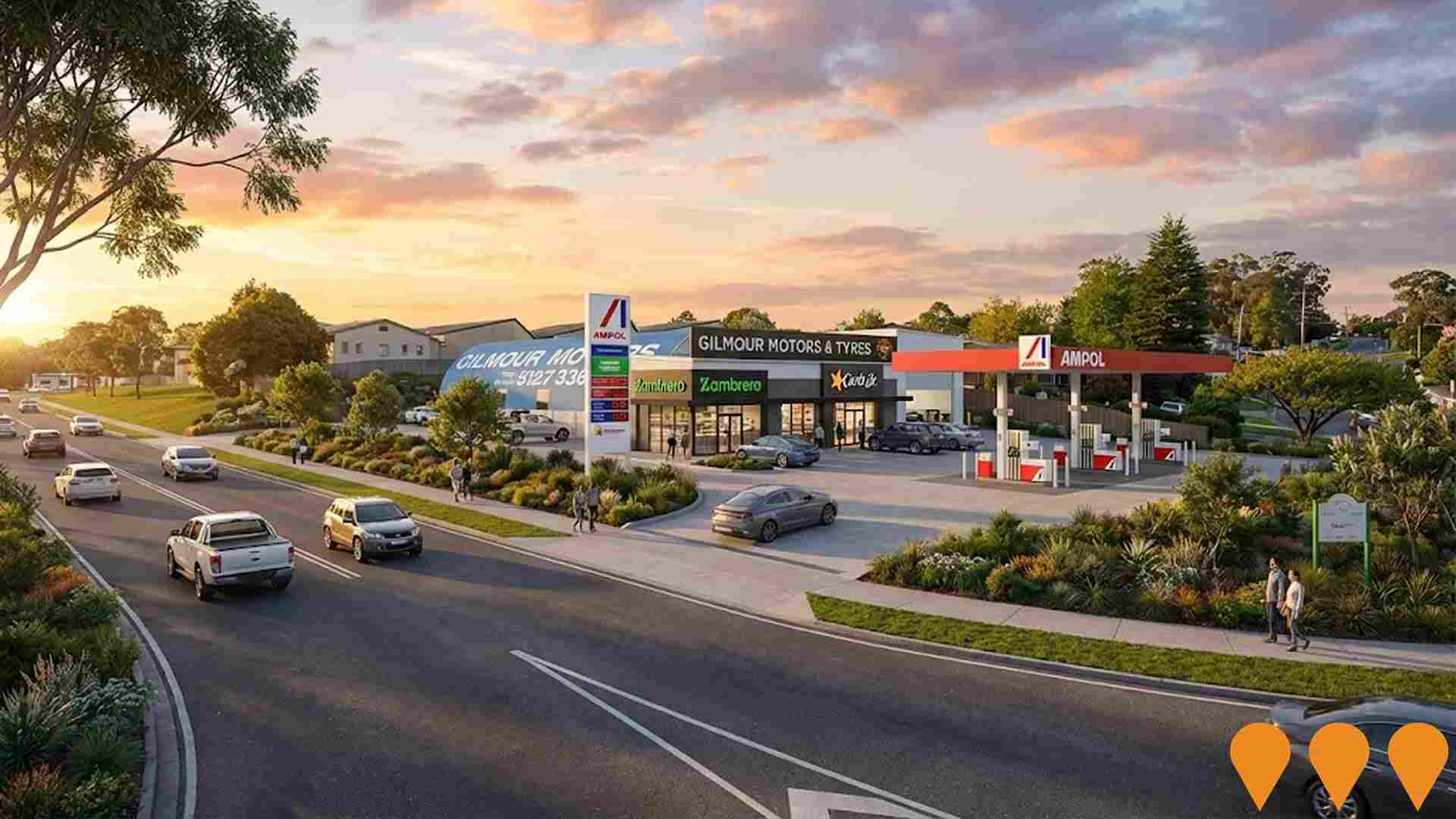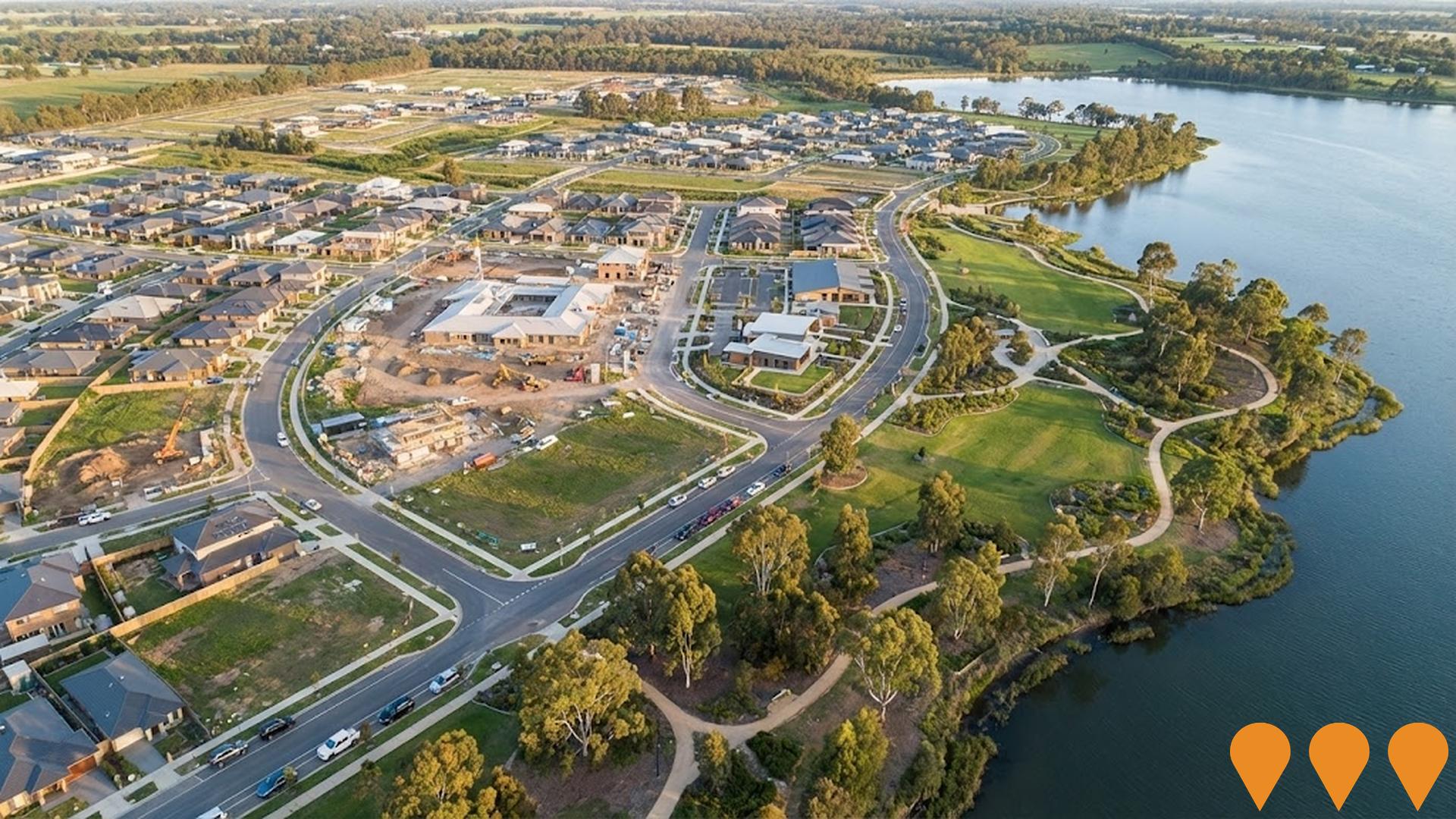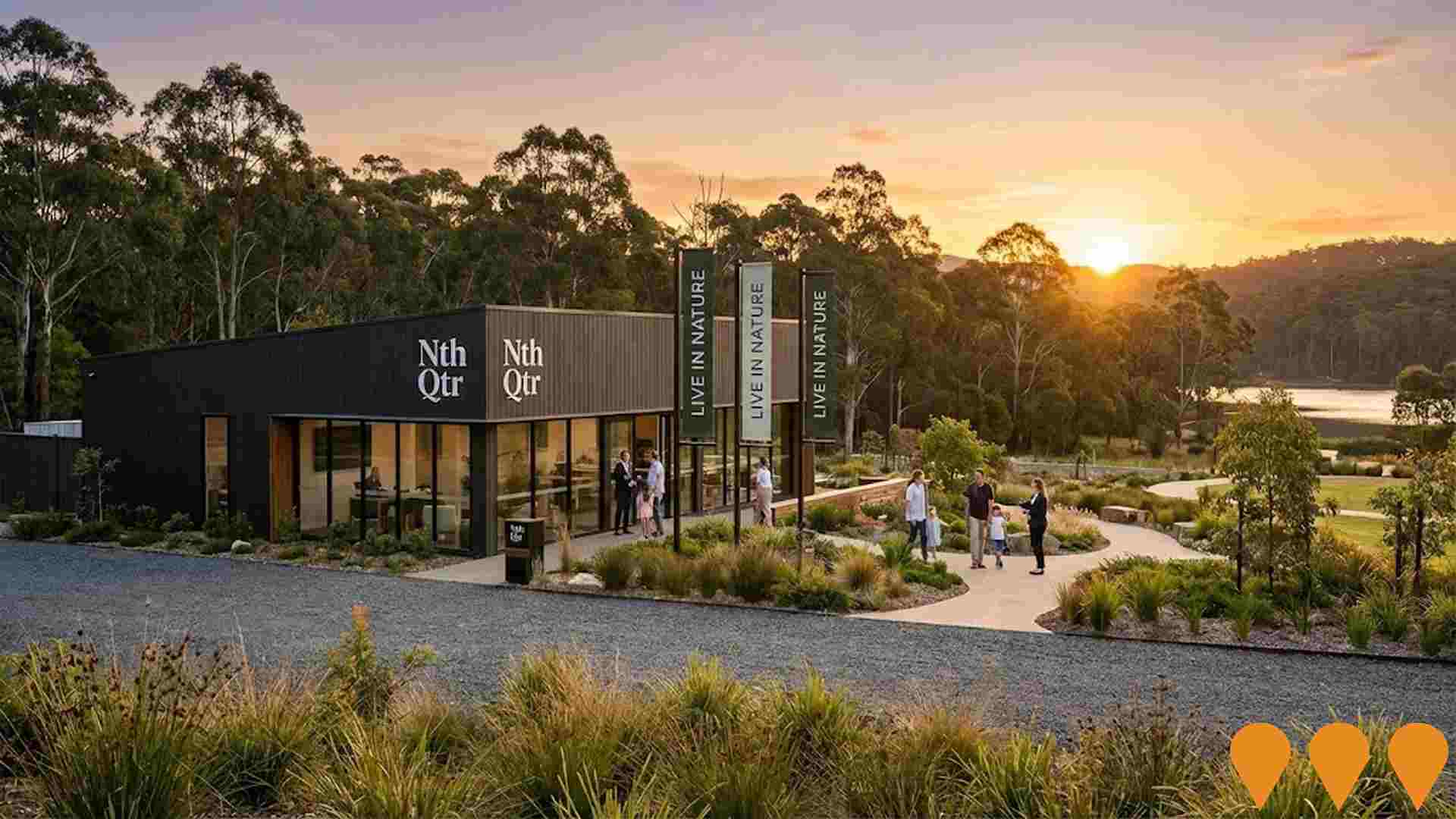Chart Color Schemes
est. as @ -- *
ABS ERP | -- people | --
2021 Census | -- people
Sales Activity
Curious about local property values? Filter the chart to assess the volume and appreciation (including resales) trends and regional comparisons, or scroll to the map below view this information at an individual property level.
Find a Recent Sale
Sales Detail
Population
Population growth drivers in Trafalgar are strong compared to national averages based on AreaSearch's ranking of recent, and medium to long-term trends
Trafalgar's population, as of August 2025, is approximately 8,677. This figure represents a growth of 309 people since the 2021 Census, which recorded a population of 8,368. The increase is estimated based on ABS data from June 2024 showing an estimated resident population of 8,596 and validated new addresses totalling 75 since the Census date. This results in a population density of 17.3 persons per square kilometer. Trafalgar's growth rate of 3.7% since the census is within 1.8 percentage points of the non-metro area's growth rate of 5.5%. Interstate migration contributed approximately 46.2% to overall population gains in recent periods, with all factors including natural growth and overseas migration being positive contributors.
AreaSearch uses ABS/Geoscience Australia projections for each SA2 area released in 2024, with a base year of 2022. For areas not covered by this data, AreaSearch employs VIC State Government's Regional/LGA projections from 2023, adjusted using weighted aggregation methods to SA2 levels. Growth rates by age group are applied across all areas for the years 2032 to 2041. Based on demographic trends and latest population numbers, Trafalgar is projected to grow by 1,470 persons by 2041, reflecting an increase of 15.9% over the 17-year period.
Frequently Asked Questions - Population
Development
AreaSearch analysis of residential development drivers sees Trafalgar recording a relatively average level of approval activity when compared to local markets analysed countrywide
Trafalgar has seen approximately 47 new homes approved annually. Over the past five financial years, from FY21 to FY25, around 239 homes were approved, with an additional 5 approved so far in FY26. On average, about 2 people have moved to the area per dwelling built over these five years.
This balance between supply and demand has resulted in stable market conditions. The average expected construction cost for new dwellings is around $460,000. In terms of commercial development, $8.5 million in approvals have been recorded this financial year. Compared to the rest of Victoria, Trafalgar shows roughly half the construction activity per person.
Nationally, it ranks among the 40th percentile of areas assessed for housing supply, suggesting limited choices for buyers and supporting demand for existing dwellings. In terms of dwelling types, new development in Trafalgar consists of approximately 69% detached dwellings and 31% townhouses or apartments. This shift from the current mix (currently 96% houses) reflects reduced availability of development sites and addresses changing lifestyle demands and affordability requirements. The estimated population density in Trafalgar is around 438 people per dwelling approval, indicating a quiet, low activity development environment. Looking ahead, Trafalgar is projected to grow by approximately 1,382 residents by the year 2041. Current development appears well-matched to future needs, supporting steady market conditions without extreme price pressure.
Frequently Asked Questions - Development
Infrastructure
Trafalgar has emerging levels of nearby infrastructure activity, ranking in the 21stth percentile nationally
Changes to local infrastructure significantly influence an area's performance. AreaSearch has identified 20 projects that could impact this region. Notable initiatives include Strategic Extractive Resource Areas (Trafalgar), The Range Estate, Trafalgar Road Network Repairs, and the Trafalgar Structure Plan, with the following list focusing on those most relevant.
Professional plan users can use the search below to filter and access additional projects.
INFRASTRUCTURE SEARCH
 Denotes AI-based impression for illustrative purposes only, not to be taken as definitive under any circumstances. Please follow links and conduct other investigations from the project's source for actual imagery. Developers and project owners wishing us to use original imagery please Contact Us and we will do so.
Denotes AI-based impression for illustrative purposes only, not to be taken as definitive under any circumstances. Please follow links and conduct other investigations from the project's source for actual imagery. Developers and project owners wishing us to use original imagery please Contact Us and we will do so.
Frequently Asked Questions - Infrastructure
Newborough Convenience Centre
A mixed use development on a 6,000m2 prime highway site along the Princes Freeway hosting tenants such as Jasbe Petroleum (Ampol), Zambrero, and Carls Jr.

Narracan Drive Redevelopment
Dual site redevelopment opportunity comprising 3 Ollerton Avenue and 84-96 Narracan Drive, offered together or separately. The combined holding is marketed for mixed outcomes across residential, medical, and aged care. 84-96 Narracan Drive is an approx. 22,680 sqm vacant infill site in NRZ4 suitable for subdivision (STCA). 3 Ollerton Avenue contains former hospital buildings on approx. 40,700 sqm in MUZ with potential adaptive reuse for health, education, residential, or commercial (STCA). Expression of Interest campaign is active with agents VicAcres and Melbourne Commercial Group.

M1 Business Park
A 33-unit warehouse precinct in the Latrobe Valley's Moe, offering modern and customisable facilities for businesses, warehousing, and service industries. Strategically located near key transport links and amenities, it supports local economic growth with over 70% units sold.

Strategic Extractive Resource Areas (Trafalgar)
Victorian Government draft planning controls to designate a Strategic Extractive Resource Area (SERA) around Trafalgar in Baw Baw Shire. The controls aim to safeguard sand and quarry resources near growth areas, reduce transport costs and emissions, and manage buffers to sensitive uses. Public consultation on the Trafalgar, Lang Lang and Oaklands Junction SERAs ran in Oct-Nov 2024. As of Aug 2025, submissions are being reviewed and a final decision by the Minister for Planning is expected in 2025.

Turras Reach (Narracan Lakes)
Masterplanned residential neighbourhood within the Lake Narracan PSP delivering about 636 lots plus a future village centre, government primary school, community facilities, and lakeside parklands with trails. The PSP and DCP are approved and land sales have commenced under the Narracan Lakes estate.

Mitchell Grove
Multi-stage residential subdivision in Moe, Victoria, offering spacious allotments over 900m2, wide streets, expansive reserves, walking tracks, vast open spaces, and integration with natural environments including wetlands and waterways. The estate promotes a safe, friendly community lifestyle with proximity to schools, shopping, and medical facilities.

Monash Views
Monash Views is a premium lifestyle housing estate in Newborough, Victoria, set amongst the Yallourn Golf Club, covering nearly 90ha with 171 lots offering large blocks and stunning rural, lake, and mountain vistas. It provides easy access to educational, sporting, and leisure facilities.

North Quarter
North Quarter is a lakeside residential land estate in Newborough, offering over 300 lots with access to Lake Narracan, parks, reserves, and community infrastructure. It focuses on a balanced lifestyle connected to nature, education, and regional amenities in Gippsland.

Employment
AreaSearch analysis indicates Trafalgar maintains employment conditions that align with national benchmarks
Trafalgar Vic. has a skilled workforce with diverse sector representation and an unemployment rate of 2.8% as of June 2025.
In this period, 4,235 residents are employed while the unemployment rate is 1.0% lower than Rest of Vic.'s rate of 3.8%. Workforce participation is similar to Rest of Vic.'s 57.4%. The dominant employment sectors include health care & social assistance, agriculture, forestry & fishing, and construction. Trafalgar shows strong specialization in agriculture, forestry & fishing with an employment share of 1.6 times the regional level.
However, health care & social assistance employs just 14.7% of local workers, below Rest of Vic.'s 16.8%. The area may offer limited local employment opportunities based on Census working population vs resident population comparison. Between June 2024 and June 2025, the labour force decreased by 0.7%, employment declined by 0.9%, causing unemployment to rise by 0.1 percentage points in Trafalgar. In contrast, Rest of Vic. saw employment fall by 0.9%, labour force contract by 0.4%, and unemployment rise by 0.4 percentage points. Jobs and Skills Australia's national employment forecasts from May 2025 project national employment growth of 6.6% over five years and 13.7% over ten years. Applying these projections to Trafalgar's employment mix suggests local growth of approximately 6.0%% over five years and 12.8% over ten years, based on simple weighting extrapolation for illustrative purposes only.
Frequently Asked Questions - Employment
Income
Income levels sit below national averages according to AreaSearch assessment
AreaSearch's data for financial year 2022 shows that Trafalgar had a median income of $48,673 and an average income of $62,320. This is lower than the national averages of $48,741 (median) and $60,693 (average) for Rest of Vic. Based on Wage Price Index growth of 12.16% since financial year 2022, estimated incomes as of September 2025 would be approximately $54,592 (median) and $69,898 (average). According to the 2021 Census, household, family, and personal incomes in Trafalgar rank modestly, between the 33rd and 33rd percentiles. The data indicates that 31.4% of individuals earn between $1,500 - 2,999, similar to the metropolitan region's 30.3%. Housing costs are manageable with 87.3% retained, but disposable income is below average at the 37th percentile. Trafalgar's SEIFA income ranking places it in the 4th decile.
Frequently Asked Questions - Income
Housing
Trafalgar is characterized by a predominantly suburban housing profile, with above-average rates of outright home ownership
The latest Census evaluation shows that dwelling structures in Trafalgar comprised 96.0% houses and 4.1% other dwellings (semi-detached, apartments, 'other' dwellings). This compares to Non-Metro Vic.'s figures of 91.6% houses and 8.4% other dwellings. Home ownership in Trafalgar was recorded at 44.3%, with mortgaged dwellings at 38.9% and rented dwellings at 16.8%. The median monthly mortgage repayment in the area was $1,500, lower than Non-Metro Vic.'s average of $1,600. The median weekly rent figure for Trafalgar was recorded at $300, compared to Non-Metro Vic.'s $320. Nationally, Trafalgar's mortgage repayments are significantly lower than the Australian average of $1,863, while rents are substantially below the national figure of $375.
Frequently Asked Questions - Housing
Household Composition
Trafalgar has a typical household mix, with a lower-than-average median household size
Family households account for 71.7% of all households, including 27.5% couples with children, 32.8% couples without children, and 10.4% single parent families. Non-family households constitute the remaining 28.3%, with lone person households at 26.4% and group households comprising 1.9%. The median household size is 2.4 people, which is smaller than the Rest of Vic. average of 2.5.
Frequently Asked Questions - Households
Local Schools & Education
Trafalgar shows below-average educational performance compared to national benchmarks, though pockets of achievement exist
The area's university qualification rate is 18.5%, significantly lower than Victoria's average of 33.4%. This presents both a challenge and an opportunity for targeted educational initiatives. Bachelor degrees are the most common at 12.6%, followed by postgraduate qualifications (3.2%) and graduate diplomas (2.7%). Trade and technical skills are prominent, with 40.8% of residents aged 15+ holding vocational credentials - advanced diplomas at 10.7% and certificates at 30.1%.
Educational participation is high, with 28.4% of residents currently enrolled in formal education. This includes 10.7% in primary education, 8.5% in secondary education, and 3.1% pursuing tertiary education. Seven schools operate within Trafalgar, educating approximately 1,434 students. The area has typical Australian school conditions (ICSEA: 992) with balanced educational opportunities. Education provision is balanced with five primary and two secondary schools serving distinct age groups. Note: where schools show 'n/a' for enrolments, please refer to the parent campus.
Frequently Asked Questions - Education
Schools Detail
Nearby Services & Amenities
Transport
Transport servicing is low compared to other areas nationally based on assessment of service frequency, route connectivity and accessibility
Trafalgar has eight operational public transport stops. These include a mix of train and bus services. There are 20 unique routes serving these stops, collectively facilitating 420 weekly passenger trips.
Transport accessibility is limited in the area, with residents generally located 1171 meters from the nearest stop. On average, there are 60 daily trips across all routes, equating to around 52 weekly trips per individual stop.
Frequently Asked Questions - Transport
Transport Stops Detail
Health
Health performance in Trafalgar is lower than average with common health conditions somewhat prevalent across both younger and older age cohorts
Trafalgar faces significant health challenges with common health conditions prevalent across both younger and older age cohorts.
The rate of private health cover is approximately 51% of the total population, which comprises about 4,433 people, slightly lagging behind the average SA2 area. The most common medical conditions in the area are arthritis and mental health issues, affecting 9.9 and 8.7% of residents respectively. Conversely, 64.9% of residents declare themselves completely clear of medical ailments, compared to 63.7% across Rest of Vic.. The area has 24.2% of residents aged 65 and over, totaling 2,096 people, which is higher than the 20.8% in Rest of Vic..
Frequently Asked Questions - Health
Cultural Diversity
Trafalgar is considerably less culturally diverse than average when assessed alongside AreaSearch's national rankings for language and cultural background related metrics
Trafalgar's cultural diversity was found to be below average, with 90.8% of its population being Australian citizens, born in Australia, and speaking English only at home as of the 2016 Census. Christianity was the predominant religion, accounting for 43.5% of Trafalgar's population, compared to 45.3% across the rest of Victoria. In terms of ancestry, the top three groups were Australian (32.7%), English (32.0%), and Scottish (8.6%).
Notably, Dutch ethnicity was overrepresented in Trafalgar at 2.4%, compared to 2.7% regionally, while Maltese was at 0.8% versus 0.4%, and Italian at 3.7% against 2.7%.
Frequently Asked Questions - Diversity
Age
Trafalgar hosts an older demographic, ranking in the top quartile nationwide
Trafalgar's median age is 43, matching Rest of Vic.'s figure and exceeding the national average of 38 years. The age profile shows a prominent group of 65-74 year-olds (13.8%) and a relatively smaller group of 55-64 year-olds (12.2%) compared to Rest of Vic.. Between the 2021 Census and present, the 75-84 age group has grown from 6.5% to 7.9%, while the 25-34 cohort has increased from 10.8% to 11.9%. Conversely, the 55-64 cohort has declined from 13.7% to 12.2% and the 5-14 group has dropped from 13.2% to 11.9%. By 2041, demographic projections indicate significant shifts in Trafalgar's age structure. Notably, the 25-34 group is projected to grow by 48%, adding 498 people and reaching a total of 1,533 from its current figure of 1,034. Conversely, population declines are projected for the 55-64 and 65-74 cohorts.



